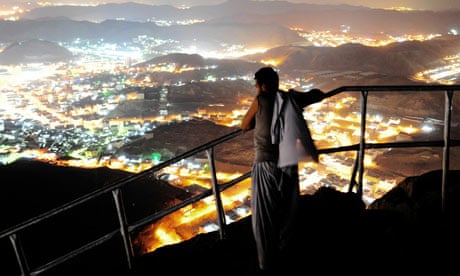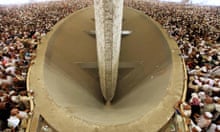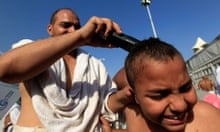The arid landscape hugging the Jeddah-Mecca highway used to hold little appeal. But now travellers can marvel at the fantastical structure rearing out of the otherwise unforgiving landscape, clearly visible from 25 miles away.
The new 485-metre-high Mecca clocktower would bear a remarkable resemblance to Big Ben, were it not for the gold crescent and Arabic calligraphy adorning it, and represents a new era for Mecca, symbolising the dizzying vision and growth of the religious tourism industry in Saudi Arabia.
An estimated 2.5 million Muslims began the annual hajj pilgrimage today and the total number of tourists to Mecca and Medina, home to the prophet Muhammad, is expected to rise from about 12 million to almost 17 million by 2025.
The clocktower is part of a project that buckles under the weight of its own statistics. Abraj al-Bait, a complex of luxury hotels, malls and apartments, has an estimated value of $3bn (£1.86bn), a built-up area of 1.4m sq metres, 15,000 housing units and 70,000 sq metres of retail space.
Hadi Helal, a marketing agent for Abraj al-Bait, says that different nationalities seek different styles of accommodation when they perform the pilgrimage, which is the fifth pillar of Islam and a once-in-a-lifetime obligation for Muslims who can afford to do it.
"Moroccan, Tunisian, Turkish, British, Algerian and South African – they like comfort and luxury. People who patronise these hotels tend to be richer. Pakistanis don't patronise high-end hotels. The closer you are the more you pay."
The level of pampering offered by some of the hotels – Asprey toiletries, 24-hour butler service, $270 chocolate selections – may jar with the ethos of sacrifice, simplicity and humility of hajj but it is not a contradiction felt by the customers snapping up royal suites at $5,880 a night, eating gelato or milling around hangar-like lobbies of polished marble in their Hajj clothing of bedsheets, towels or burqas. Raffles is reporting 100% occupancy for it 211 rooms.
Helal said: "As long as you do what you have to do for the hajj, it does not mean you have to eat bread or lobster, or sleep on a bed or the floor. It is not for me to say how people should stay when they get here."
The appetite for walk-in wardrobes and wet-rooms is outstripped, however, by demand for the hajj. Even now, the number of tourists is still only a fraction of the world's Muslim population of 1.8 billion, with a year-on-year growth of 6.7%.
Business reports conclude that Saudi tourism, especially the religious variety, is recession proof. The government's commission for tourism and antiquities said revenue from tourism this year would reach $17.6bn, then almost double again by 2015. Business Monitor International forecasts there will be 319,000 rooms, up from 218,000 in 2009 in Saudi Arabia.
The country's strengths, it adds, are its "strong and growing" religious tourism industry and, with some understatement perhaps, "the financial resources" for infrastructure investments.
As a sign of how seriously the country is taking its tourism industry – and its potential to diversify the economy –, a $6bn, 276-mile rail link will connect the two holy cities, slashing journey times, while a $2.4bn upgrade will increase the capacity of Medina airport from 3 million to 12 million passengers a year. King AbdulAziz International airport in Jeddah will also expand its capacity, from 30 million travellers by 2012 to 80 million when finished.
The latest efforts to improve the pilgrimage experience is the al-Mashaaer al-Mugaddassah metro, which will carry people between Muzdalifah, Mina and Mount Arafat, important locations for pilgrimage rituals. At its peak it will transport 72,000 passengers and go some way to relieving the interminable congestion and frayed nerves experienced every year.
The view from al-Bait reveals the physical impact of this soaring ambition. All around the Grand Mosque and the Ka'bah, which are overshadowed by cranes and skyscrapers, construction continues at a frenzied pace. Mountains have been razed to make way for towers– a pile 'em high and sell 'em high approach to hospitality – and homes demolished.
The mountains of Mecca – Omar, Kaabah, Khandama – will no longer exist. The Shamiya district has all but disappeared. From the terrace of al-Bait to street level there is a stench of machine oil and cement that mingles with the more familiar odours of hajj – sweat, hardship and flipflops.
As many towers as possible are being built, says Helal. "There used to be small houses, they were old-fashioned. The Mecca opportunity is growing. More people will come to the hajj, the demand used to be more than supply, now they are about the same. We will try to make the supply more. The big-name hotels come here because they know there is business here. People will not stop coming to hajj. They cannot do hajj anywhere else."
While Saudi Arabia is catching up with the likes of its glitzier, Emirati neighbours in terms of hotel stock it is not, Helal believes, an attempt to lure Muslim holidaymakers away from places such as Dubai. "There is no entertainment in Mecca. You do not come here for that. You come, you do hajj. The government will spend more money to make Mecca beautiful, they want to satisfy everyone."
The Mecca makeover is a source of pride and respect for those working in the hotel and tourism sector.
Asim Garout, a soft-spoken and thoughtful 38-year old, has lived in Mecca all his life. Now working at the Makkah Clock Royal Tower, he says the Saudi government is publicising how much it values the holy city. "They want Mecca to be the heart of Islam. They want to be proud of it. They want to add value and make it a landmark.Everyone talks about Greenwich, but for Muslims they try to find a time for them," he says, referring to the clock tower.
Shabbier hotels and dwellings are gone, replaced by narrow towers, features that are fast becoming the norm in Mecca. "We try to maximise our service to accommodate the number of pilgrims who come here, a mixture of modern and traditional. I feel sad that people have lost their homesThey get compensation and new homes – at times I am sorry,, but then I think of the pilgrims who have struggled to find somewhere nice to sleep. Sometimes, you have to sacrifice."
How the hajj works
Hajj is the fifth pillar of Islam, an obligation on every able-bodied Muslim who can afford to do it and a journey with rites that must be performed at a certain time, in a certain way.
While the hajj has strong associations with the prophet Muhammad, its rituals stretch back thousands of years to the time of Abraham and symbolise his trials with God and Satan.
The experience begins with millions of pilgrims orbiting the Ka'bah, the black cube at the heart of the Grand Mosque in Mecca, before shuttling between the hills of Safa and Marwah.
From Mecca they travel to Mina, where they spend the night, and then on to Mount Arafat, the place of the prophet's final sermon, for prayer and reflection.
At sunset they leave for Muzdalifah, where they collect 49 pebbles in order to carry out the stoning of the devil ritual on their return to Mina, throwing seven pebbles at vast pillars on three separate occasions.
After this ritual, animals are sacrificed and pilgrims shave their hair. They then return to Mecca to perform another circuit of the Ka'bah, going on to Mina for three more rounds of pebble throwing.
Before they leave Mecca they must perform a final circuit of the Ka'bah.




